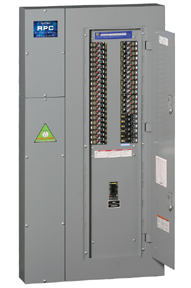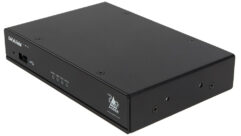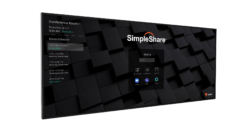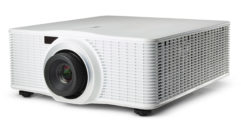
SVC Podcast – Show Notes – Show 173-2
In this edition of the SVC Podcast, Contributing Editor Bennett Liles talks with Evan Hamilton and Josh Holowicki of AV integration firm E2i Design on the topic of power monitoring and management. E2i specializes in house of worship AV solutions and the discussion centers on how churches can avoid costly repair and replacement of AV gear through protection of power supplies and proper power sequencing of amplifiers, projectors, media players and signal distribution equipment.
For Part 1
Links of interest:
- E2i Design – (Educate, Empower & Inspire) Specialists in house of worship AV installation and consulting
- Detailed Power Management article from Analog Devices
- Power Management Basics from Power Electronics
Download Podcast Here:
https://s3.amazonaws.com/nb-svc/public/public/173-2_Power_Management_Ham…
This is the SVC Podcast from Sound & Video Contractor Magazine with Evan Hamilton and Josh Holowicki of E2i Designs. Show notes and equipment links for the podcast are on the web site of Sound & Video Contractor Magazine at svconline.com.
We’re talking power control and management. It controls everything in networks and AV gear and it has never been a more challenging time with bad power and ever more delicate AV circuits and lighting gear. Evan Hamilton and Josh Holowicki with church integration firm E2i Design are going to give us the integrator view on today’s power challenges. That’s right here on the SVC Podcast.
Evan and Josh, so good of you to join us on the SVC Podcast from E2i Design and Evan is joining us from Oklahoma City and Josh is coming to us from Detroit. We’re discussing power management and monitoring. Last week we talked with Alan Tschirner at Lyntec for the manufacturer view on it and you two are the integrator end of this. Tell us a little about E2i Design. What kind of company is it?
Josh: Hi, Bennett. Thanks for taking some time with us. It’s cool to be here with you and sharing about what’s going on in our world on these great topics. So E2i Design is a company that started many, many years ago and it was kind of birthed to help ministries. More specifically we work exclusively in the house of worship market. We do some projects that are non-house of worship based, but our main focus is that. Everybody on our team has had or currently has experience in technical leadership roles at very high-level influential ministries all across the country. And so as each of us sort of stepped out of our full-time jobs at the churches we decided that we wanted to come together and have a company that was really focused on ministry and what we’d be able to offer to the house of worship market that’s very, very different from what other folks are doing out there. So we do kind of a top-to-bottom thing for every ministry we work with. We analyze them and their systems and see who they’re about and what they’re about doing. And we look at education as a big part of what we do and training and teaching and coaching. And then equipment is also part of the deal so actually put the technology in their hands that’s needed and then we use it to help build their teams and empower them to do what they need to do on a week in and week out basis. So it’s different, it’s unique, it’s fun and we really enjoy what we get to do. [Timestamp: 2:35]
Now, if you’ve got a large church with different buildings, maybe even different campuses, they call you in and they want a better handle on their power monitoring and control. How aware are they of power issues and what do they ask you to do as far as installing AC power management systems?
Evan: Well, Bennett, most of the organizations are actually aware of power control that we work with. Many of them are actually unaware of the benefits other than sequencing something on and off in the correct order. That’s kind of where the knowledge gap would stop, I guess, in a lot of them; not all of them. But we always try to approach it from hitting key AV components first, large-scale audio/video rooms, larger boardrooms or conference rooms, kids’ rooms, things that actually need the sequencing piece of it. And then from there we look for large power-consuming devices; dimming racks, motor-controlled systems, things like that. Things that would be great to have monitored and protected in some form or fashion. Just because it’s a sequence device or a controlled device doesn’t necessarily mean that you’ve got the power monitoring and the control aspects behind that. You typically just have one or the other. [Timestamp: 3:40]
And at most churches, particularly the smaller ones, it’s like Alan and I were talking about last week. Everything is probably on one big breaker and kabam, everything is suddenly on or off. There are repeated thumps and pops through their sound system and then they wonder what happened to their speakers.
Evan: That’s absolutely right. In a lot of cases it’s simplified way too easy by the sense of an electrician just putting in a light switch on the wall and assuming that’s all that’s needed. And in the complex digital AV systems that are done today, there’s a right and a wrong way to turn things on and off and that’s the very first approach for sure. [Timestamp: 4:16]
A lot of churches are getting into motorized lighting, especially those that have live music. The power protection on the moving lights is even more essential. They can really get messed up and it becomes obvious when they stop behaving.
Josh: That’s a really important point that you make there in that it’s sort of multifaceted. One, with the way the technology has moved along in the last several years it’s rare, I mean rarest of rare, when we’re putting in a traditional dimming control system like we used to in the old days. Now with LED technology and automated lighting technology all the control and the dimming and everything is now electronic and it’s local at each fixture. So two important points that kind of speak to what you were just saying there, one is that you don’t want to leave that technology running 24 hours a day, 7 days a week. In the old days when you dimmed the lights on the dimmer they were off and that was that. But nowadays when the light is not emitting any light, no light coming out of it, it doesn’t mean that it’s powered off. So one thing that’s really important is that that technology be powered down when you’re not using it mostly so that you’re not putting excess wear and tear on the fans that keep them cool as well as bringing in excess dust. Basically you’re making them dirtier and you’re lowering their lifespan in terms of their fans and things by just letting them run. So we really encourage our clients to always make sure that that stuff is powered down effectively so it’s not just running. But then in the other sense it’s really important when it comes to the sequencing and everything to make sure the protections are in place as best that we can from major voltage changes, lightning storms, things like that, because the technology is very sensitive and we want to make sure that we can protect the equipment as much as we can because that’s a big investment. And so when we’re looking at the sequencing and the power management we want to make sure that we’re looking at ways that we can kind of protect that from those outside events that oftentimes we just don’t have any control over. [Timestamp: 6:11]
We also talked last week about the condition of the power grid in the U.S. and with the switching power supplies in widespread use there’s quite a bit more noise in the power now and the long-term effects can be quietly devastating to AV and network systems.
Josh: Yeah. We have had, unfortunately, very recently we had a client who had blown out some driver’s on their stage monitors because we believe that as we went through things that it wasn’t getting powered down in the correct order and so they would get those pops that you mentioned earlier. And you do that enough times and you weaken it and eventually they popped it good one day and that was the end of it. So we ended up replacing six drivers on their units and we got the system in and really made some recommendations that we needed to do sequencing power and things like that on the whole system. And unfortunately they hadn’t budgeted properly to do the whole system with sequencing only a small portion of it. And so we had that problem and had we been able to sequence the whole system front-to-back like we wanted to we feel very strongly we would have been able to protect that. [Timestamp: 7:16]
And when they do get smart, hopefully before they have to call you to come in and replace a lot of things, and they’re looking for a power monitoring system and the various features, what things are the most useful for it to do? What sort of capabilities do they look for?
Evan: Well, Bennett, there’s a lot of companies out there that do both power sequencing control and monitoring, if you will. And we’ve found it best to find one that works well with you as an integrator and partners well with you and embrace them and do the walk together with the client. Make sure that everyone’s needs are met and fully understood. In regards to what’s available on the market everything from voltage and amperage monitoring, current in and out, how much power drawn, how much consumption. And then there’s dashboards and algorithms to factor all sorts of things all the way down to what your expected monthly electric bill could be. In the industry we’re in, with the clients that we work with, the things that are most important would be voltage inbound, making sure that we’ve got a consistent voltage and we’ve got some brownout protection built into whatever our current monitoring and sequencing would be. In the event of a brownout we could power things down before voltage got too low and would cause susceptible damage. And then outside of that it’s over-current protection. And for us those are really probably the two biggest protectors and monitors needed. The rest of the stuff is just pretty to look at. [Timestamp: 8:37]
It can be more than you can comprehend or work with, particularly if you’re part time on a church tech crew. What kind of knowledge and skillset is needed to take full advantage of the latest power management systems?
Evan: Luckily with the manufacturers that are in the market today they design systems that are really very intuitive for the end user whether they’re a volunteer, an employee at a church, an organization or a university, or a professional. There’s granual levels of control that can often be given, granual levels of access that can be given for viewing and/or making changes to it. And for the most part things are extremely intuitive and very much driven around the digital world that we live in. Almost everyone owns a touchscreen phone at this point and understands how to operate that. And they would be doing very similar things, whether it’s a mouse or a keyboard or computer or phone device. [Timestamp: 9:31]
And these systems can be set up to send alarms and automatic emails of just the important stuff. I’m sure that if you want to you can set it up to give you every detail but usually it’s just the primary parameters.
Evan: Absolutely, yeah. So all sorts of alarms and notifications and alerts, email or text message either one is no problem. And then some systems go as far as to allowing contact closure sensors such as occupancy sensors and things like that to be installed in the rooms. And you can trigger conditional actions based on if the occupancy sensor hasn’t been tripped in the last 15 or 20 minutes. It can go ahead and begin to shut the system down. [Timestamp: 10:05]
Well that’s very handy. I work in a university environment and I find that people know how to turn things on but they’re not so good at turning things off.
Evan: Yeah, and in a lot of cases the guy that turns it on wants to leave a little earlier than the other people that are in the room.
Right. Been that guy lots of times. So what sort of things do you think are going to be coming down the line in the future of power management systems? More ease of use or more sophisticated systems or both?
Josh: I think one of the things we’re seeing definitely is on the access side of things for the system. You know, we’re looking at – and Evan can speak certainly more to this a little bit – but the ability to log in remotely and gain control over what’s going on. So just kind of speak to that previous conversation of well how do we control the system? You can of course program things to shut off at certain hours, or if you do end up leaving the facility and you go aw shoot, we forgot to the shut the stuff down or whatever, that available technology to log in remotely now as well as to do some of those program sequences is pretty cool and is really opening up a lot of opportunity for us in the market with those capabilities. [Timestamp: 11:10]
I like the ones that include motion sensors in case there is something going on in the room that’s not scheduled. If you start to shut things off either manually or on an automated schedule and movement has been sensed you may want to hold off.
Evan: That’s absolutely correct, Bennett. Absolutely correct.
So exciting things happening in power management. I think people are becoming more aware of it maybe because they’ve had to and when you sell these systems outside the country there can be even more challenges with the power grid.
Evan: Yeah. The thing that most people don’t realize is the power grid/power infrastructure, if you will, in the U.S. and abroad is something that wasn’t just built yesterday or even 10 years ago. It’s decades upon decades of expansion and growth and Band-Aids, to be completely honest. And anything that we can do on the front side to help protect a large investment of an organization for really minimal cost, we’d love to help be a part of that and help make those things happen. [Timestamp: 12:06]
It’s great that people are becoming more aware of power issues and I’m sure that’s going to keep E2i Design busy in the house of worship market. I wish you plenty of success with that. We’ve been talking with Evan Hamilton and Josh Holowicki of E2i Design. Thanks for being with us.
Josh: Thanks so much.
Evan: Thanks, Bennett.
Thank you for joining us. Show notes and equipment links are on the website of Sound & Video Contractor Magazine at svconline.com. Be back here with us next week for the SVC Podcast.









